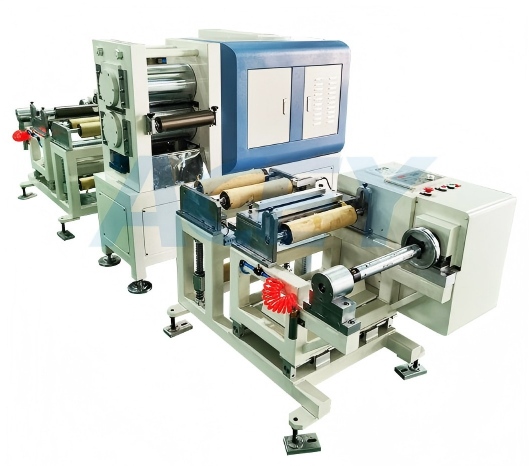Categories
New Blog
Process Steps Affecting Lithium-ion Battery DCIR (DC Internal Resistance)
November 07 , 2025
① Electrode Coating
During electrode coating, the coating quality has a significant impact on DCIR. Uneven coating is a common problem. If the active material is too thick or too thin in certain areas, it will cause uneven current distribution. When the current is unevenly distributed on the electrode, it leads to increased local resistance, directly raising the DCIR. Furthermore, insufficient coating will create areas without active material, forming "virtual contacts." These "virtual contacts" are like breaks in a circuit, causing significant resistance to current flow, significantly increasing internal resistance, and thus affecting the DCIR test results.
ACEY-AC300J electrode coating machine employs automated control, enabling high-precision uniform coating, thickness monitoring, and drying control. This high-performance coating effectively reduces thickness fluctuations, ensuring electrode consistency and thus lowering DCIR deviation.

② Electrode Rolling
The degree of electrode rolling also significantly affects DCIR. If the rolling is too loose, the electrode porosity is too high, and the contact between the active material and the current collector is not tight. This hinders electron transport between the active material and the current collector, resulting in higher internal resistance and an increased DCIR. Conversely, if the rolling is too tight, it damages the active material structure and blocks ion channels. Blocked ion channels make ion transport difficult, also increasing DCIR.
ACEY-RP-300x350 automatic rolling press machine improves electrode density and compaction through precise control of roller gap and pressure, ensuring consistent electrode surface flatness and porosity. This helps optimize electron and ion transport performance, thereby stabilizing DCIR performance.

If burrs generated during electrode cutting/slitting are not removed, a series of problems will occur. Burrs may puncture the separator, causing a micro-short circuit. A micro-short circuit will cause abnormal current paths inside the battery, increasing resistance and resulting in an abnormally high DCIR. Furthermore, burrs may also cause poor contact between the electrode and the tab, further affecting current transmission and also causing an abnormally high DCIR.
ACEY-SM300 electrode siltting machine is a semi-automatic slitting machine for preparing electrode of batteries and prismatic batteries in R&D laboratories and production line. It is suitable for rechargeable lithium batteries cathode and anode electrode of the longitudinal cutting, the electrode of the base material can be aluminum foil and copper foil, sliced edge tidy, high dimensional accuracy, no burr, it is an important equipment in plate processing.

The quality of tab welding is an important factor affecting DCIR. Incomplete or false soldering during welding can lead to a significant increase in the contact resistance between the electrode tab and the current collector. Incomplete or false soldering weakens the connection between the electrode tab and the current collector, resulting in higher contact resistance when current flows, thus causing DCIR to exceed the limit. Additionally, residual solder slag can cause poor contact, which is also a common cause of excessive DCIR. The presence of solder slag hinders normal current transmission, increases resistance, and consequently affects DCIR test results.
ACEY-USW-3000 ultrasonic metal spot welding machine is specifically designed for joining nickel and aluminum materials in battery manufacturing or other applications. It ensures uniform and strong welds, effectively controls welding heat input, reduces incomplete welds and slag, improves conductivity, and lowers DCIR.

② Cell Winding/Stacking
Process control during cell winding/lamination has a significant impact on DCIR. Poor winding alignment, such as electrode misalignment or stacking misalignment, reduces the effective contact area of the positive and negative electrode active materials. Reduced effective contact area increases ion transport resistance, making it difficult for ions to move within the battery, thus leading to an increase in DCIR. Furthermore, uneven winding tension can cause separator wrinkles, which affect ion conduction, further increasing resistance and affecting DCIR test results.
IV. Conclusion
In summary, the core processes affecting lithium-ion battery DCIR testing are concentrated in three main stages: electrode preparation, cell assembly, and formation/aging. The coating, rolling, and cutting/slitting processes in electrode preparation; the tab welding, winding/stacking, and electrolyte injection processes in cell assembly; and the formation and aging processes—each stage's process control has a significant impact on DCIR. During lithium-ion battery production, it is crucial to strictly control the process parameters of these key processes to ensure that the DCIR test results meet requirements, thereby improving the quality and performance of lithium-ion batteries. Furthermore, for abnormal DCIR readings, a comprehensive investigation and analysis should be conducted starting with these core processes to identify and resolve the problem promptly.